How to Photograph Ezo Brown Bears in Hokkaido – Tips, Ethics & Camera Settings
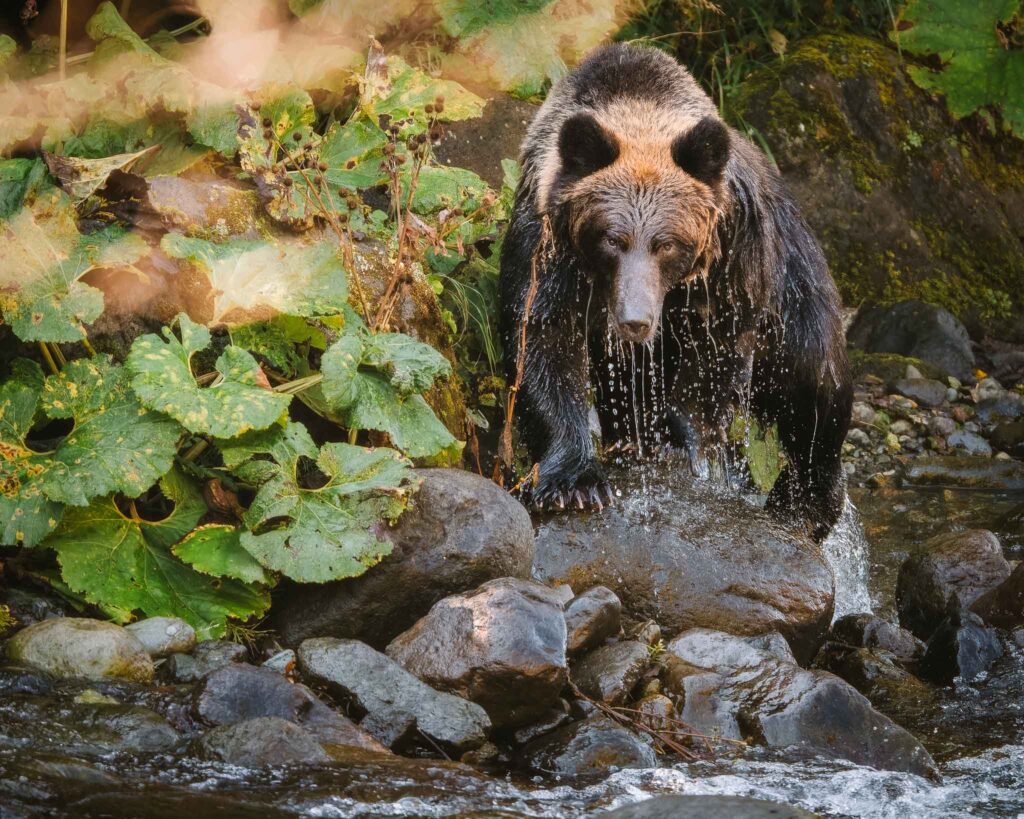
Photographing Ezo brown bears — a subspecies of the Ussuri brown bear (Ursus arctos lasiotus) — offers a rare glimpse into Japan’s wild frontier. These bears roam the forests and mountains of Hokkaido, Japan’s northernmost island, and tower in both size and symbolism. Weighing between 200 and 400 kilograms, with some males exceeding even that, they are the largest land mammals in Japan — and among the most awe-inspiring subjects for wildlife photography.
They also hold deep cultural significance. In the mythology of the Ainu people — the Indigenous inhabitants of Hokkaido — the bear is revered as a sacred creature. Known as kimun kamuy, or “mountain god,” the Ezo bear was honored through ritual hunts and ceremonies such as the iomante, where a bear cub was raised and ceremonially returned to the gods. For centuries, bear furs, claws, and bile were essential trade goods, gathered with profound respect for the spirit of the animal.
Even today, the presence of the Ezo brown bear contributes to Hokkaido’s image as a place of untamed nature—vast, wild, and sometimes dangerous. From the deep forests of Shiretoko to the remote ranges of Daisetsuzan, encountering a brown bear remains one of the most powerful and humbling experiences a person can have in the Japanese wilderness.

My Experience Photographing Bears in Hokkaido
I first saw bears back when I was working in Whistler, Canada—long before I took up photography. I remember spotting them around the village just before winter started and again in the spring. I always loved seeing them—such big, majestic animals. One moment that’s always stuck with me was during a short-term hotel job. I looked out a window and saw a black bear standing upright on its hind legs, peering at something. It was an incredible sight.
Now, I live in Niseko, Hokkaido, in Japan’s far north. Last year, I stayed for the summer season for the first time, and I took the opportunity to learn about and try photographing Hokkaido’s Ezo brown bears. I’d heard that autumn is a good time to spot them, especially around the Shiretoko Peninsula, so I planned a trip there. But before heading that far, I tried somewhere closer to home—a remote town a few hours south of Niseko where locals said bears are often seen.
I first visited the area on a hiking trip with some friends and met a few locals while there. The landscape was stunning—dense forests, hidden valleys, and beautiful waterfalls. But it was wild country, full of insects, ticks… and bears. One of the locals we hiked with carried bear spray and an air horn, which he used to make noise as we entered the forest. He shared stories of bear encounters—bears fishing in the rivers, even entering the town. But he also told me about a growing fear among farmers and residents. Because of this fear, bears are sometimes shot on sight when they come near the town.
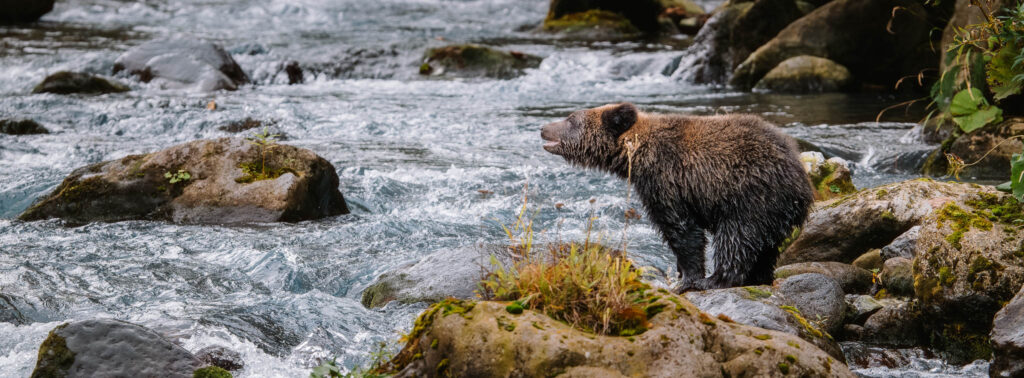
A while later, I went back alone, having found a few remote valleys on Google Maps that looked promising. I chose a gravel road that followed a salmon-filled river, hoping to catch a glimpse of a bear fishing. I waited in my car, scanning the area. But I saw nothing. Later, the same local told me that since the town began culling bears, sightings had become rare—the bears had learned to stay hidden. He even warned me not to tell anyone if I did see one, or the location might be shared and the bear shot.
Wanting to try my luck in a more protected area, I headed to Shiretoko Peninsula, one of the most beautiful places I’ve been in Japan. I stayed in the small coastal village of Utoro, at the base of the peninsula, and explored some potential spots nearby where I could watch safely from my car. My plan was to arrive early, park, and wait quietly to see if a bear might appear at a safe distance.
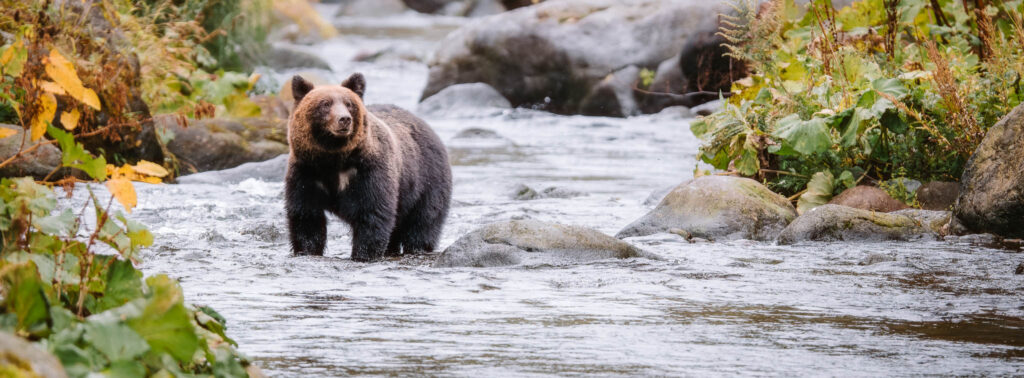
I had my Nikon Z8 and Nikon Z 180-600mm lens, giving me plenty of reach to stay far back while still getting close-up shots. After checking a few areas I had pinned, I picked a spot that looked promising—a clear view up a river, with a couple of other photographers already there. That gave me hope.
About an hour later, my patience paid off. A massive male bear emerged from the bushes above the road and crossed about 60 meters away. He was enormous—far bigger than any black bear I’d seen in Canada. After disappearing into the thick brush between the road and the river, he soon reappeared in the water, fishing. From where I was positioned, I had a clear view of the river, so I started shooting from a safe distance.
Unfortunately, being near the road meant passing cars quickly noticed the bear. Soon, several vehicles had pulled over and people gathered to watch. Park rangers arrived to manage the crowd, making sure no one blocked the road or got too close. The bear, for its part, didn’t seem to care about the attention.
The next morning, I went back to the same spot. As I was driving down the winding valley road, a mother bear and her cub suddenly emerged from the forest above and stepped onto the road behind me. A full fence on the other side prevented them from crossing, so they were forced to walk along the road itself. I was worried that a car might come around a corner and hit them, so I drove about 40 meters in front of them with my hazard lights on, trying to keep them safe. After about 100 meters, they reached the end of the fence and disappeared back into the forest on the downhill side. I didn’t get any photos—I was too focused on making sure they were okay.
But later, back at the river, the same mother and cub appeared again. This time, I had a good view. The cub played in the river, tossing around moss in its mouth, then stood on its hind legs. Later, it climbed trees while the mother kept fishing. There were about 10 photographers nearby, all keeping a respectful distance of around 50 meters. The bears didn’t seem bothered at all.
I kept my shutter speed high in case I caught the moment of a bear catching a salmon. There was plenty of light, so I could keep my ISO low. I mostly shot wide open at f/6.3 for soft backgrounds, but stopped down occasionally when I wanted more detail or sharpness. I had to be careful with exposing the dark bear against the bright water—some shots ended up with blown highlights, especially where the sun hit the water directly. Unfortunately, I didn’t get to see a bear actually catch a salmon, but I still managed to capture a good range of images I was happy with.
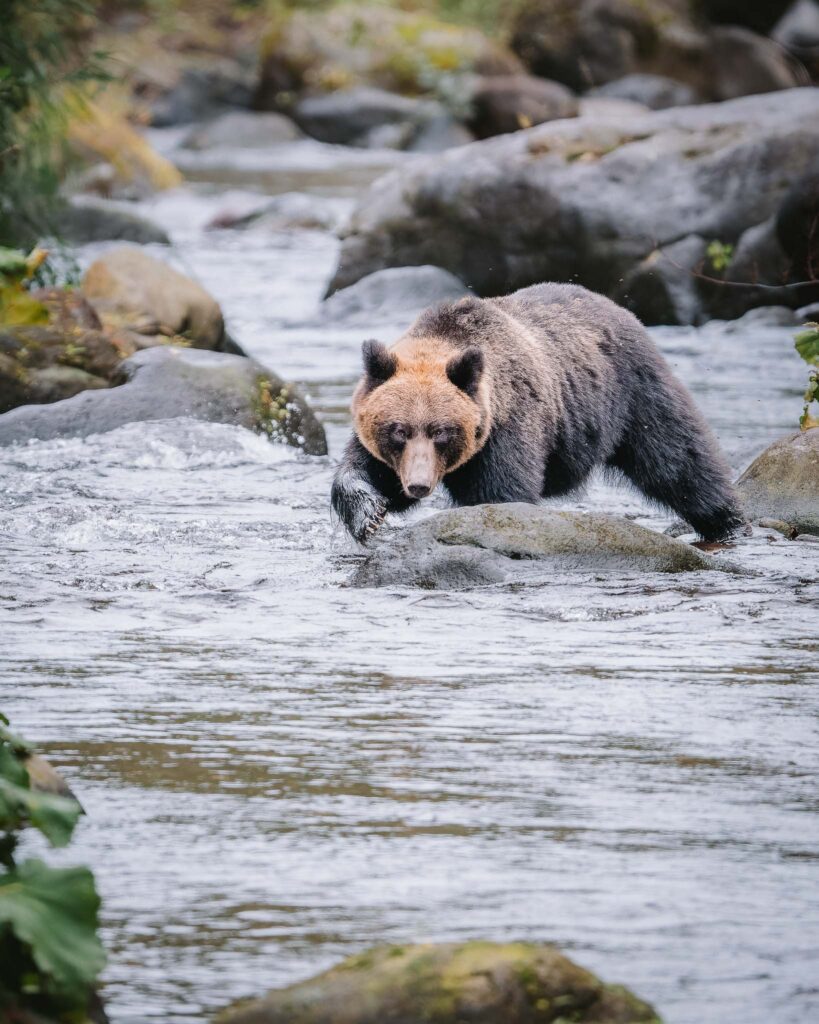
That afternoon, I took one of the cruise boats that follow the coast of the Shiretoko Peninsula in hopes of spotting bears by the shoreline. Unfortunately, I didn’t see any that day—just plenty of deer. But it was still fascinating. One of the stops along the way was Rusha Bay, a wide bay surrounded by forest and beach, rich in history. The old fishing buildings and boat ramps still stand along the shore. Until fairly recently, fishermen operated out of this bay—and incredibly, they worked side by side with the bears. The bears would roam the beaches, minding their own business, and the fishermen respected their presence. There was no conflict—just quiet coexistence.
It’s a powerful contrast to the fear-driven narratives we hear today. Even though I didn’t see a bear here, the sense of place and history made it a memorable and meaningful part of the trip.
The Survival Struggle of Hokkaido’s Brown Bears
Learning about Hokkaido’s bears—how to safely photograph them, and hearing stories from people who live in bear country—has opened my eyes to a sad truth: the Ezo brown bear is under serious pressure.
In the past few years, bear sightings and encounters in Hokkaido have risen, and tragically, so have the number of serious incidents and fatalities. But in Japan, the media attention has blown the issue out of proportion. Even a single sighting now becomes headline news. The result? Widespread fear, panic, and calls for more extreme control measures.
One of the most repeated claims is that bear numbers have exploded since hunting restrictions tightened in the 1990s—rising from around 4,000 in 1990 to over 12,000 by 2020. But this is a very rough estimate, built on models, not actual counts. Many experts and locals agree that the real number is likely much lower. Still, that inflated figure is often used to justify bear culls.
There’s no doubt that encounters are increasing, but this isn’t because bears are “taking over”—it’s because we’ve changed the landscape. Climate change and certain forestry practices have reduced natural food sources like acorns and salmon. At the same time, human development is pushing deeper into bear habitat—new roads, hotels, tourist spots. This leaves bears with fewer places to go. They’re being pushed to the edges, where they start scavenging near farms and villages just to survive.
There are now very few areas left in Hokkaido where brown bears can move freely from the mountains to the ocean—their natural range—without crossing roads or human settlements. Much of their historical habitat has been carved up by roads, farms, and tourist development. But Shiretoko Peninsula remains one of the last places in Japan where bears can still roam almost untouched, traveling through forests, along rivers, and down to the sea with minimal human interference. It’s a rare exception—a stronghold of wilderness in an increasingly fragmented landscape.

Another thing I’ve noticed—especially comparing it to my time in Canada—is how different the public understanding of bears is. In Canada, people know how to behave in bear country. You carry bear spray, make noise on the trail, and store food away from camp. In Japan, even in bear areas, there’s very little awareness. People fear bears, but don’t know how to react when they see one. That fear turns into panic, and panic makes everything more dangerous—for both people and bears.
What’s worse is that this fear is amplified by the media. Bear attacks make national news. Even peaceful sightings are treated like a crisis. Meanwhile, other dangers—like Asian hornets, which kill dozens every year, or even murder, which is extremely rare but still more likely than a fatal bear attack—barely get mentioned. But say the word “bear,” and people lose their minds.
People forget that in places like Rusha Bay, fishermen and bears once worked side by side—sharing the same space without conflict. Mutual respect kept the peace. The bears stayed calm, and the people left them alone.
That sense of balance feels like it’s being lost. In 2021, over 1,000 bears were culled in Hokkaido. In 2023, the number jumped even higher—1,422 bears shot. These are low estimates and it is likely far higher. That’s not conservation. That’s a crisis.
Bears aren’t the enemy. They’re just trying to survive in a world that’s changing faster than they can adapt. If we want them to still be here for future generations—to see them in the wild, to photograph them, to know they exist—we need to stop reacting with fear and start thinking about how we can share the land again.
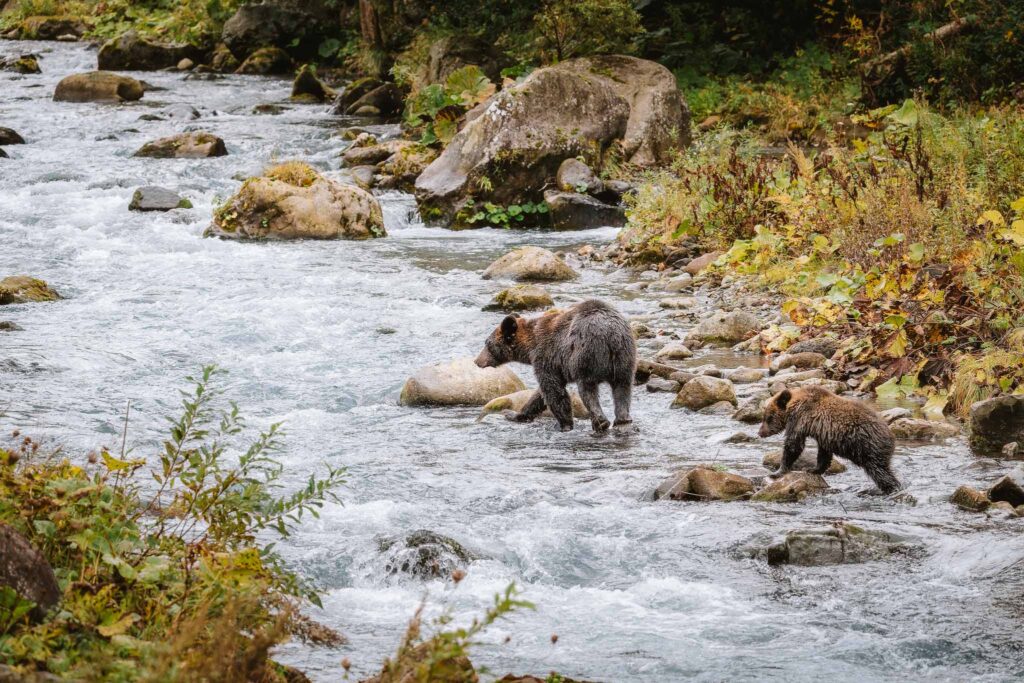
How to Safely Act and Photograph Bears
Photographing bears is a powerful experience—but it comes with responsibility. Your safety and the bear’s well-being should always come first.
Here are some key principles I follow:
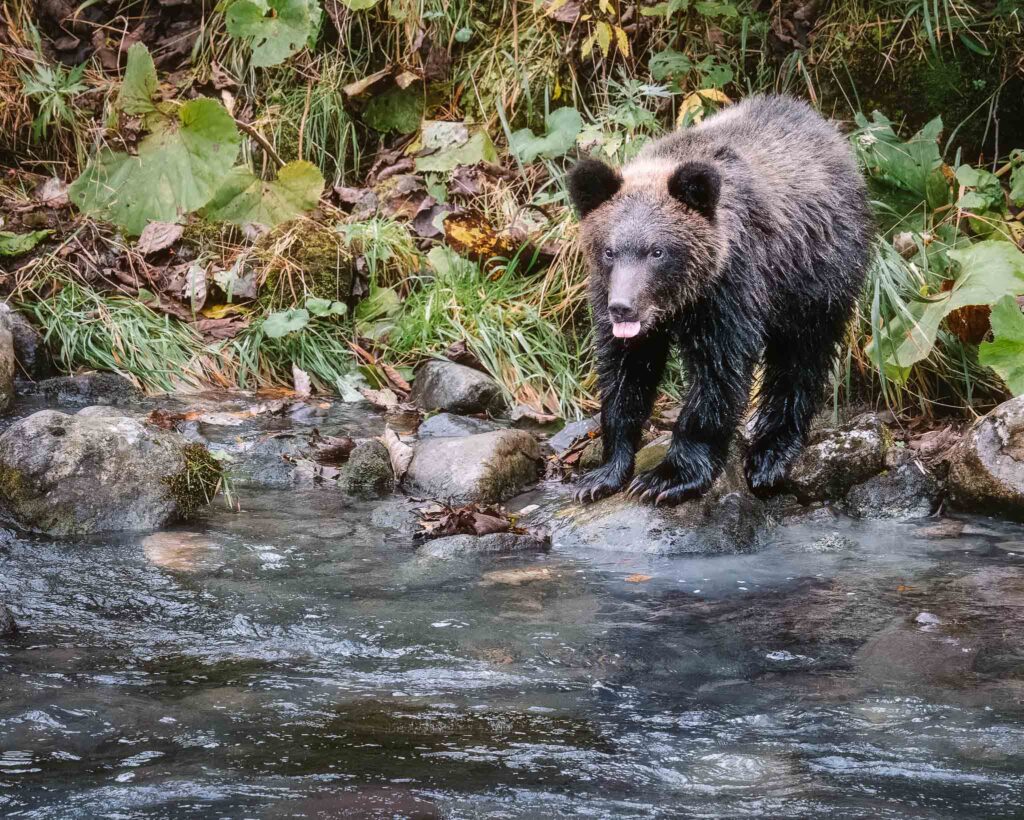
– Keep your distance. Use a long lens (like my Nikon 180-600mm) so you can stay far away. Never try to get closer for a “better shot.” If a bear changes its behavior because of you, you’re too close.
– Never surprise a bear. When hiking, make noise—talk, clap, or carry a bell. Most bears prefer to avoid humans, and letting them know you’re coming reduces the chance of a dangerous encounter.
– Carry bear spray—and know how to use it. It’s a last resort, but having it accessible (not buried in your bag) is important in case of a close encounter.
– Stay near your car or in a safe position when photographing, especially in known bear areas. I often shoot from or near my vehicle or a location with a quick exit route.
– Never bait or lure bears with food. It’s unethical and dangerous. Bears that associate humans with food are often the first to be killed.
– Respect park guidelines and closures. If an area is restricted due to bear activity, it’s for good reason.
These tips are just a starting point. If you’re unfamiliar with bear behavior, consider going with a local guide or doing a safety course first. Respect and caution will keep you—and the bears—safe.
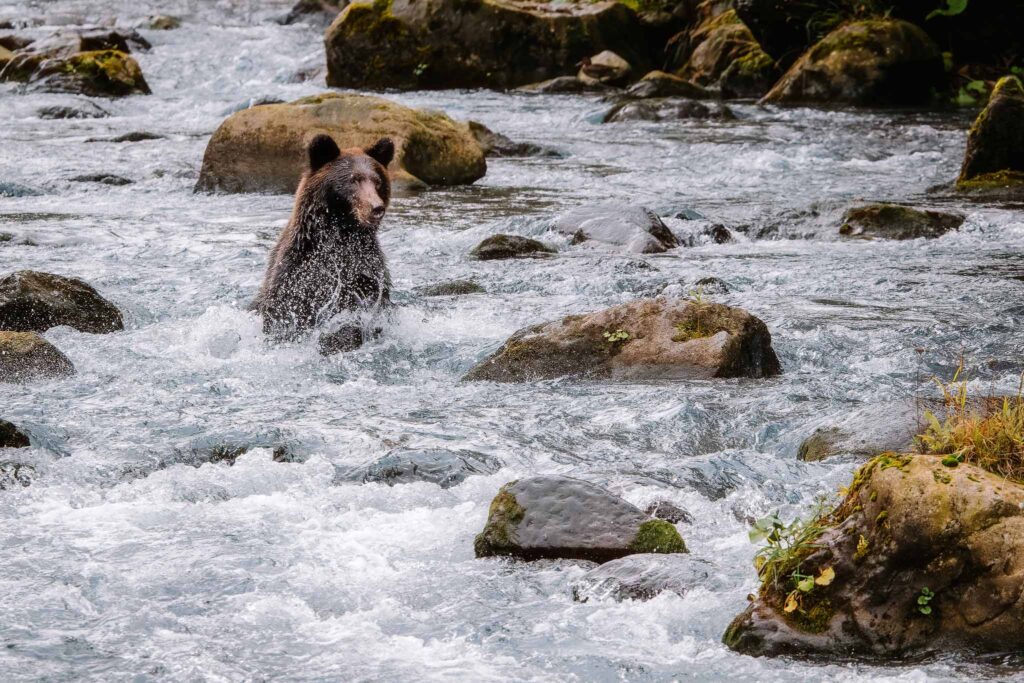
Conclusion: A Wild Encounter Worth Protecting
Photographing the Ezo brown bear has been one of the most powerful experiences of my life. Standing in the quiet forests of Hokkaido, watching these massive, intelligent animals move through their natural world—it’s something I’ll never forget.
But the more time I spent learning about them, the more I realized how fragile that world really is. Between shrinking habitats, media-driven fear, and rising cull numbers, these bears face challenges far beyond what most people see on the surface.
They’re not villains. They’re survivors—navigating a landscape that’s being reshaped faster than they can adapt. And while encounters with them should be approached with caution and respect, they should also be met with understanding, not fear.
If we want future generations to see bears roaming the rivers of Shiretoko or playing in the forest with their cubs, we need to rethink how we coexist with them. That means protecting wild spaces, challenging sensational narratives, and choosing education over eradication.
I went looking for photos. What I found was something much deeper—an urgent reminder of what we stand to lose, and why it’s worth fighting for.
👉 If you’re interested in wildlife photography in Hokkaido, you might also enjoy my post on how to photograph Steller’s sea eagles in Rausu.
📬 For more photography guides and stories from the wild, visit the main blog — and don’t forget to sign up for email updates to get new posts straight to your inbox.
